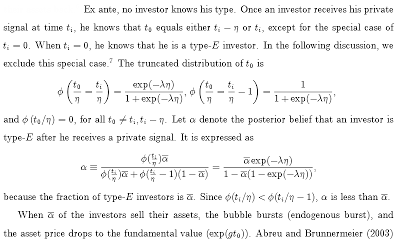CASE STUDY ON CRITICAL READING
OK, you are working for this guy: Video: http://youtu.be/R8y6DJAeolo. He walks into your office and drops this on your desk early in the morning before you have had a chance to slurp your coffee and gobble your jelly-donut: Case Study Critical Reading_Bubbles. He wants a full report. He wants to know what causes bubbles and busts.
What do you tell him about the report he gave you? How long before you reached your conclusion? What evidence do you present for your conclusion? Time is precious.
What do you suggest should be the next step to gain an answer for your hedgie boss?
How efficient are you at getting to the essence of the document? Stuck?
Ask Hannibal Lechter:
Case Study “Response”
In its report Globalization and Monetary Policy Institute Working Paper No. 167, entitled “The Boy Who Cried Bubble” by authors Yasushi Asako and Kozo Ued.
The article is 44 pages long. In the opening paragraph on page two in the Introduction, the authors state “History is rife with examples of bubbles and bursts. A prime example is the recent financial crisis that started in the summer of 2007; However, we have limited knowledge of how bubbles arise and how they can be prevented.” (Right there–you have your conclusion. These guys have no clue how bubbles occur. Secondly, seeing any higher level math means ignorance and folly. How can human action be quantified with mathematical precision–the fatal conceit). Tell your boss that the paper is useless or even misleading.
One could safely stop reading right at that point knowing full well that what follows cannot possibly be anything but self-serving platitudes and incomprehensible mathematical gibberish.
And that is precisely the case. The mathematical gibberish starts on page five and continues for the entire remainder of the document.
Here is a quick sample from page seven.
All the remaining pages are equally incomprehensible to all but the geekiest of geeks. Here is another example from page 39.
Hiding Behind Nonsensical Math
I am quite sure there are some academic geeks who understand the formulas presented by Yasushi Asako and Kozo Ued.
Regardless, it’s all mathematical nonsense in light of their ridiculous conclusion stated upfront “We have limited knowledge of how bubbles arise and how they can be prevented.”
Ben Graham argues, “higher-level math implies a level of precision that does not exist in the real world.” (p. 259 of The Intelligent Investor)
Read more at http://globaleconomicanalysis.blogspot.com/2014/01/bubblicious-questions-what-causes.html#ueRA5dx1OFAvUKC9.99
SEALED AIR CASE STUDY
Video https://www.hightail.com/download/elNLTG01MHczeUp4Tk1UQw Link Expires May 24 2014
Case Materials:




14 responses to “CS on Critical Reading Skills; Sealed Air Video”